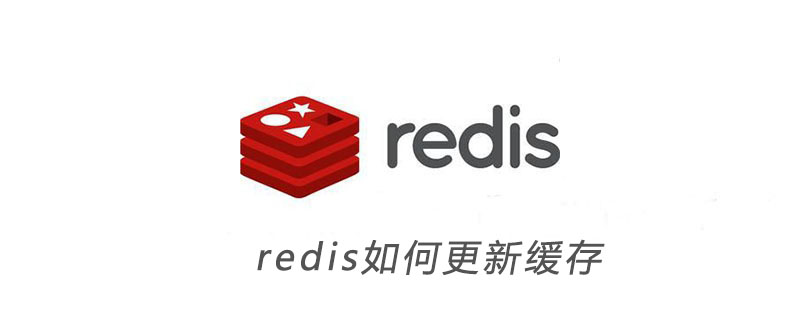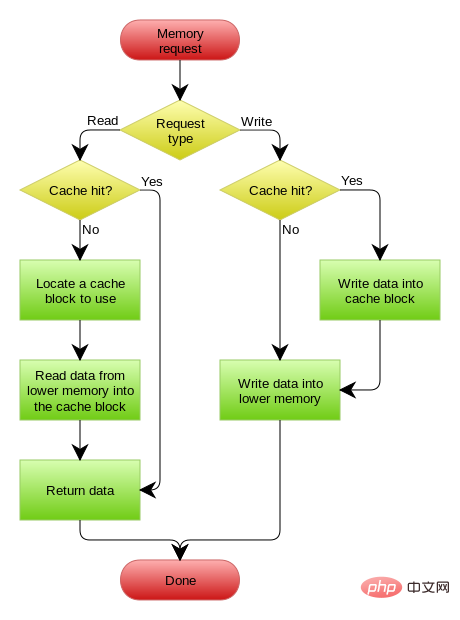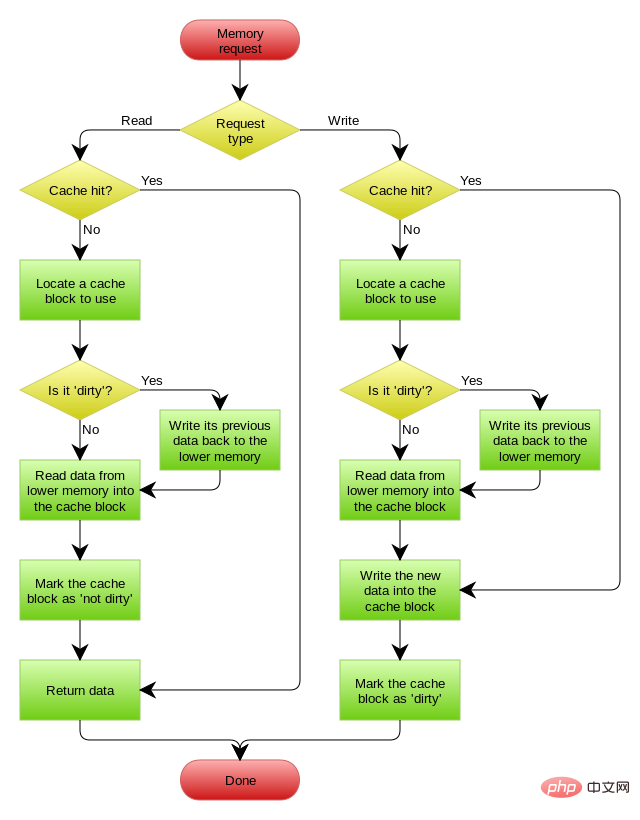How redis updates cache
There are four Design Patterns for redis to update the cache: Cache aside, Read through, Write through, Write behind caching. Let’s take a look at these four Patterns one by one.

Cache Aside Pattern
This is the most commonly used pattern. The specific logic is as follows: (Recommended learning: Redis video tutorial)
Invalidation: The application first gets the data from the cache. If it does not get it, it will get the data from the database. After success, , put into the cache.
Hit: The application fetches data from the cache and returns after fetching it.
Update: First save the data into the database, and then invalidate the cache after success.
Note that our update is to update the database first, and then invalidate the cache after success. So, can this method avoid the problem mentioned earlier in the article? We can figure it out.
One is the query operation, and the other is the concurrency of the update operation. First of all, there is no operation to delete the cache data, but the data in the database is updated first. At this time, the cache is still valid, so concurrency The query operation takes data that has not been updated.
However, the update operation immediately invalidates the cache, and subsequent query operations pull the data out of the database. Unlike the logic problem at the beginning of the article, subsequent query operations will always fetch old data.

Read Through
Read Through routine is to update the cache during the query operation, that is, when the cache expires (expiration or LRU swap out), Cache Aside is the caller's responsibility to load the data into the cache, while Read Through uses the cache service to load it itself, so it is transparent to the application.
Write Through
Write Through routine is similar to Read Through, but it occurs when data is updated. When data is updated, if the cache is not hit, the database is directly updated and then returned. If the cache is hit, the cache is updated, and then the Cache itself updates the database (this is a synchronous operation)
The picture below comes from Wikipedia's Cache entry. You can understand the Memory as the database in our example.

Write Behind Caching Pattern
Write Behind is also called Write Back. Some students who know the Linux operating system kernel should be very familiar with write back. Isn't this the Page Cache algorithm of the Linux file system? Yes, you see the basics are all the same. Therefore, the foundation is very important. I have said this not once before.
Write Back routine, in a nutshell, when updating data, only the cache is updated, not the database, and our cache will update the database asynchronously in batches.
The advantage of this design is that the data I/O operations are extremely fast (because the memory is directly operated). Because of the asynchronous write backg, write backg can also merge multiple operations on the same data, so the performance improvement is Quite impressive.
However, the problem it brings is that the data is not strongly consistent and may be lost (we know that abnormal shutdown of Unix/Linux will cause data loss, because of this).
In software design, it is basically impossible for us to make a design without defects, just like time is exchanged for space in algorithm design, and space is exchanged for time. Sometimes, strong consistency and high performance, High availability and high performance are in conflict. Software design has always been about trade-off.
In addition, the implementation logic of Write Back is relatively complex, because it needs to track which data has been updated and needs to be flushed to the persistence layer. The write back of the operating system will be truly persisted only when the cache needs to be invalidated, for example, when the memory is not enough, or the process exits, etc. This is also called lazy write.
There is a flow chart of write back on wikipedia. The basic logic is as follows:

For more Redis related technical articles, please visit Getting Started with Redis Learn in the tutorial column!
The above is the detailed content of How redis updates cache. For more information, please follow other related articles on the PHP Chinese website!

Hot AI Tools

Undresser.AI Undress
AI-powered app for creating realistic nude photos

AI Clothes Remover
Online AI tool for removing clothes from photos.

Undress AI Tool
Undress images for free

Clothoff.io
AI clothes remover

AI Hentai Generator
Generate AI Hentai for free.

Hot Article

Hot Tools

Notepad++7.3.1
Easy-to-use and free code editor

SublimeText3 Chinese version
Chinese version, very easy to use

Zend Studio 13.0.1
Powerful PHP integrated development environment

Dreamweaver CS6
Visual web development tools

SublimeText3 Mac version
God-level code editing software (SublimeText3)

Hot Topics
 Solution to 0x80242008 error when installing Windows 11 10.0.22000.100
May 08, 2024 pm 03:50 PM
Solution to 0x80242008 error when installing Windows 11 10.0.22000.100
May 08, 2024 pm 03:50 PM
1. Start the [Start] menu, enter [cmd], right-click [Command Prompt], and select Run as [Administrator]. 2. Enter the following commands in sequence (copy and paste carefully): SCconfigwuauservstart=auto, press Enter SCconfigbitsstart=auto, press Enter SCconfigcryptsvcstart=auto, press Enter SCconfigtrustedinstallerstart=auto, press Enter SCconfigwuauservtype=share, press Enter netstopwuauserv , press enter netstopcryptS
 Golang API caching strategy and optimization
May 07, 2024 pm 02:12 PM
Golang API caching strategy and optimization
May 07, 2024 pm 02:12 PM
The caching strategy in GolangAPI can improve performance and reduce server load. Commonly used strategies are: LRU, LFU, FIFO and TTL. Optimization techniques include selecting appropriate cache storage, hierarchical caching, invalidation management, and monitoring and tuning. In the practical case, the LRU cache is used to optimize the API for obtaining user information from the database. The data can be quickly retrieved from the cache. Otherwise, the cache can be updated after obtaining it from the database.
 Caching mechanism and application practice in PHP development
May 09, 2024 pm 01:30 PM
Caching mechanism and application practice in PHP development
May 09, 2024 pm 01:30 PM
In PHP development, the caching mechanism improves performance by temporarily storing frequently accessed data in memory or disk, thereby reducing the number of database accesses. Cache types mainly include memory, file and database cache. Caching can be implemented in PHP using built-in functions or third-party libraries, such as cache_get() and Memcache. Common practical applications include caching database query results to optimize query performance and caching page output to speed up rendering. The caching mechanism effectively improves website response speed, enhances user experience and reduces server load.
 How to upgrade Win11 English 21996 to Simplified Chinese 22000_How to upgrade Win11 English 21996 to Simplified Chinese 22000
May 08, 2024 pm 05:10 PM
How to upgrade Win11 English 21996 to Simplified Chinese 22000_How to upgrade Win11 English 21996 to Simplified Chinese 22000
May 08, 2024 pm 05:10 PM
First you need to set the system language to Simplified Chinese display and restart. Of course, if you have changed the display language to Simplified Chinese before, you can just skip this step. Next, start operating the registry, regedit.exe, directly navigate to HKEY_LOCAL_MACHINESYSTEMCurrentControlSetControlNlsLanguage in the left navigation bar or the upper address bar, and then modify the InstallLanguage key value and Default key value to 0804 (if you want to change it to English en-us, you need First set the system display language to en-us, restart the system and then change everything to 0409) You must restart the system at this point.
 How to use Redis cache in PHP array pagination?
May 01, 2024 am 10:48 AM
How to use Redis cache in PHP array pagination?
May 01, 2024 am 10:48 AM
Using Redis cache can greatly optimize the performance of PHP array paging. This can be achieved through the following steps: Install the Redis client. Connect to the Redis server. Create cache data and store each page of data into a Redis hash with the key "page:{page_number}". Get data from cache and avoid expensive operations on large arrays.
 Can navicat connect to redis?
Apr 23, 2024 pm 05:12 PM
Can navicat connect to redis?
Apr 23, 2024 pm 05:12 PM
Yes, Navicat can connect to Redis, which allows users to manage keys, view values, execute commands, monitor activity, and diagnose problems. To connect to Redis, select the "Redis" connection type in Navicat and enter the server details.
 How to find the update file downloaded by Win11_Share the location of the update file downloaded by Win11
May 08, 2024 am 10:34 AM
How to find the update file downloaded by Win11_Share the location of the update file downloaded by Win11
May 08, 2024 am 10:34 AM
1. First, double-click the [This PC] icon on the desktop to open it. 2. Then double-click the left mouse button to enter [C drive]. System files will generally be automatically stored in C drive. 3. Then find the [windows] folder in the C drive and double-click to enter. 4. After entering the [windows] folder, find the [SoftwareDistribution] folder. 5. After entering, find the [download] folder, which contains all win11 download and update files. 6. If we want to delete these files, just delete them directly in this folder.
 PHP Redis caching applications and best practices
May 04, 2024 am 08:33 AM
PHP Redis caching applications and best practices
May 04, 2024 am 08:33 AM
Redis is a high-performance key-value cache. The PHPRedis extension provides an API to interact with the Redis server. Use the following steps to connect to Redis, store and retrieve data: Connect: Use the Redis classes to connect to the server. Storage: Use the set method to set key-value pairs. Retrieval: Use the get method to obtain the value of the key.






